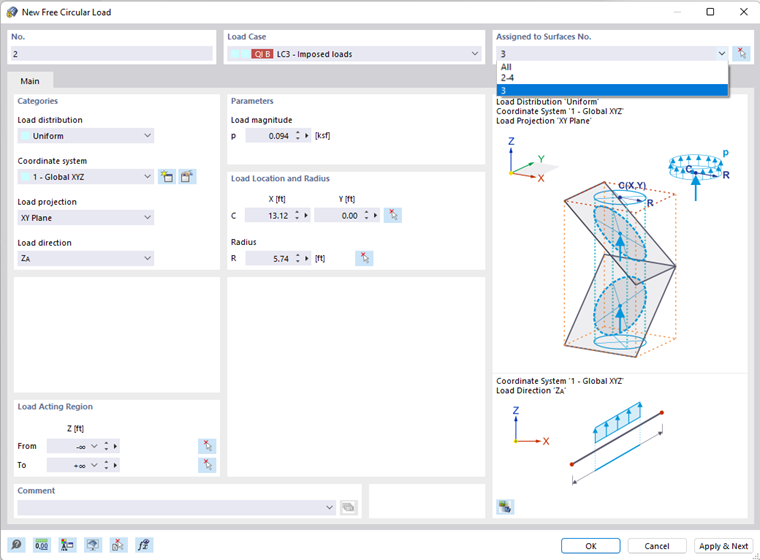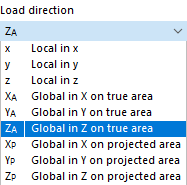A free circular load acts as a uniform or linearly variable surface load on a circular, freely definable part of a surface.
In the list, select the "Load Case" to which you want to assign the load.
In the "Assigned to Surfaces" dialog section, you can control the effect of the circular load. Several options are available for selection in the list (see the image New Free Circular Load):
- "Empty": The load does not act on any surfaces.
- All: The load is applied to all surfaces that are cut perpendicular to the projection plane, starting from the load locations.
- "Number": The load acts only on the surfaces of the specified numbers.
Categories
The following options are available for selection in the "Load distribution" list:
- Uniform: The circular load acts with a constant magnitude.
- Linear: The load has a linearly variable magnitude.
If the circular load does not refer to the global "Coordinate system" XYZ, you can select a user-defined coordinate system or create a new one.
In the "Load projection" list, select on which of the global planes (XY, YZ, or XZ) you want to project the load. From the center point C of the load location, RFEM "constructs" a straight line perpendicular to this projection plane and applies the load with radius R at the intersection points of this straight line with the surfaces.
Select the "Load direction" from the list to define the effect of the load. Depending on the coordinate system, the local surface axes x, y, z, the global axes X, Y, Z, or the user-defined axes U, V, W are available for selection.
Parameters
Specify the "Load magnitude" of the force. For a linearly variable load, you have to enter two load values: the value pC at the center and the value pR at the boundary line.
Load Location
Enter the coordinates of the circle center "C". You can also use the
![]() button to define the point graphically. Then, enter the radius "R" to define the zone for the circular load.
button to define the point graphically. Then, enter the radius "R" to define the zone for the circular load.
Load Acting Region
As described above, the load acts on the surfaces that are cut perpendicular to the projection plane, starting from the load location. If you have selected the "All" option in the Assigned to Surfaces dialog section, you can limit the effect of the load by means of geometric criteria.
By default, the load acts indefinitely in the interval from -∞ to +∞. You can use the "From" and "To" text boxes to reduce the load effect to certain zones.

